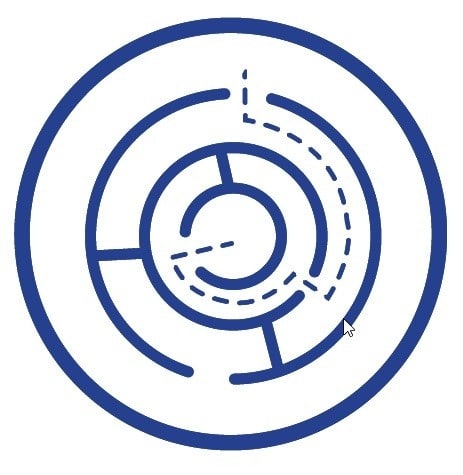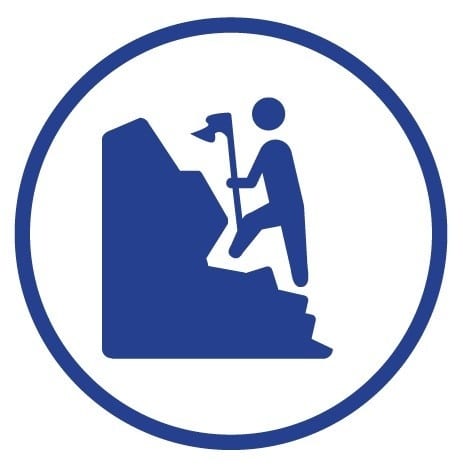Hardiness and Resilience Curriculum
What Is Resilience?
The ability to recover quickly from adversity and stressful situations.
What Factors Contribute to Resilience?
A person’s level of resilience is made up of many factors and Hardiness is the primary psychological factor contributing to resilience. The hardier you are, the more resilient you are.
Hardiness and Resilience Assessment
The Hardiness Resilience Gauge™ (HRG™) is grounded in over 30 years of research and development and provides valuable insight into an individual’s level of hardiness and their ability to cope with stressful and unexpected situations. Research has documented the protective nature of hardiness – people who are higher in hardiness are less likely to experience the negative effects of stress on health and performance. Those high in hardiness are not invulnerable to stress, but they do not experience the same degree of negative stress-related outcomes as those who are low in hardiness.
The HRG is used globally and has a long history of successful use with various groups, including employees and leaders within organizations, military personnel, law enforcement, healthcare personnel, students, and athletes. Leaders who cultivate characteristics of hardiness have more cohesive teams that are better able to adapt to stress and adversity and are more resilient to change.
The HRG measures how effectively a person can cope with stress. It helps understand one’s generalized style of functioning that encompasses cognitive (thinking), emotional (feeling), and behavioural (acting) qualities that are instrumental for predicting how resilient an individual will be. The assessment is scored online, and it take approximately 10 mins to complete. The Individual 9-page report provides a total Hardiness score in addition to scores measuring three qualities that are instrumental for predicting how resilient an individual will be. These three qualities are referred to as Challenge, Control, and Commitment and are defined below:

CHALLENGE
Seeing change and new experiences as exciting opportunities to learn and develop.
An appreciation for variety and change, a desire to be adventurous and explore, and a motivation to learn and grow from failures. Also captured within the Challenge aspect of hardiness is the tendency to perceive difficult situations as challenges to overcome, rather than as threats. Whereas a person low in Challenge is likely to perceive unexpected changes as overwhelming and threatening, someone high in Challenge is likely to perceive the same unexpected change as an exciting opportunity to learn and grow. ¬The Challenge aspect of an individual’s hardiness profile contributes to one’s ability to be flexible and adapt when faced with stressful circumstances.

CONTROL
Belief in one’s ability to control or influence events and outcomes.
A strong belief that an individual has the ability to influence outcomes in their life, and is willing to make choices about life and accept responsibility for those choices. It captures how in control the person feels of their destiny, despite the uncertainty that is often associated with the future. People who have a strong sense of Control tend to approach novel situations with confidence because they have the conviction that they can influence results. Researchers have long recognized that people inherently desire control and it is beneficial for an individual to feel that they are in control of situations that are occurring. Feeling in control facilitates the sense that one can safely and effectively manage their environment and life circumstances, even when stressful situations come their way.

COMMITMENT
Tendency to see the world and day-to-day activities as interesting, meaningful, and having purpose.
The extent to which one is engaged in a variety of life domains, and how interesting and meaningful they see their existence. People who have a high Commitment score have a strong sense of purpose in life and tend to see their experiences, big or small, as meaningful and important. They tend to be fully engaged in the world around them. Those high in Commitment are attentive and in tune with the situations, conversations, and relationships that they are involved with. This Commitment component of an individual’s hardiness pro le contributes to the person’s sense of internal balance and their ability to be attentive and aware, ultimately helping them to make realistic assessments of stressful circumstances.
Applications
The HRG is a versatile tool that can be used in a variety of contexts to provide greater insight into an individual’s ability to effectively deal with stress.
With Leaders
Not only do hardy leaders exhibit superior leadership qualities, they can also influence the hardiness of the people they are leading. When leaders gain insight into their own hardiness they better understand how to respond to stressful and changing team dynamics. This allows leaders the opportunity to be the person that others model their behavior after and establish within their teams how stressful situations are dealt with and understood.
With Teams
Teams that consist of members who are higher in hardiness are more cohesive and better able to work through obstacles. The HRG can be used to identify hardy team members whose qualities could be leveraged in an adaptive way to help facilitate hardiness in other team members. Research has shown that teams who have insight into their hardiness profiles form more cohesive units and are better prepared to deal with stressful and changing situations. Teams who are hardy embrace unexpected situations and directly deal with stressful circumstances. They are more motivated and prepared to tackle change with a clear plan of action for achieving the outcomes they want (Bartone et al., 2002).
In the Workplace
The HRG can be used by employers (e.g., HR and OD consultants, psychologists, or HRG certified users) to provide valuable insight when looking for individuals who will excel and continue to perform when faced with the inevitable stress and changes that occur in all workplaces. Supplemented by additional sources of information, such as interviews and the results of other assessments, the HRG can make the recruitment and selection process more reliable and efficient. The HRG can also be used in a developmental context. Hardiness is comprised of a coachable set of characteristics. The HRG enables qualified professionals to create tailor-made training programs to improve the hardiness and resiliency of employees, teams, and the company as a whole. The HRG can also be used to evaluate performance and the well-being of employees, especially those employees who are in high-stress positions.
In High-Stress Occupations
Research has consistently documented the protective nature of hardiness for people in high-stress occupations (e.g. military, law enforcement, and medical). The HRG can be used as a tool to identify employees who might be particularly vulnerable to experiencing the consequences associated with stressful occupations (e.g., burnout, post-traumatic stress disorder, and depression). Having these potentially vulnerable people focus on developing their hardiness can help mitigate the negative consequences of job stress exposure.
Within high-stress occupations, there are often resilience training opportunities offered to help protect against the typical outcomes associated with job-related stress (e.g., burnout). The HRG could be used as a measure of effectiveness for these resiliency-training programs.
With Athletes
Athletes are constantly exposed to stressful situations (e.g., high expectations, losses, injuries). ¬ The HRG can be used to help prepare athletes for these situations and predict an athlete’s likelihood of effectively coping with changing or stressful circumstances. For example, research has shown that athletes who are higher in hardiness are more likely to perceive the opportunity for growth in sport-related injuries, ultimately helping them with their recovery. Athletes who are high in hardiness are better at managing the anxiety that often comes with competition, and using it to enhance their performance.
In Academic Institutions
The HRG is also suitable for students (18 years and older). It can be used in colleges, universities, and technical schools to provide insight into students’ resilience and well-being. The HRG can have important implications for student counseling programs where the primary aim is to help students adjust to university. In particular, the HRG could be used as part of a strategy to identify students who are at high risk of problems related to academic stress and who could benefit from interventions such as student counseling programs.
Assessment Overview
The HRG individual report is designed for use in a wide variety of coaching and development situations. It focuses on the impact of a person’s hardiness across multiple domains in their life. The HRG report is customized based on the client’s responses, resulting in a personalized, actionable experience complete with developmental strategies to increase hardiness.
The report also highlights potential consequences of imbalances within an individual’s hardiness profile and gives information about how people can facilitate hardiness in those around them.
You can view sample reports and the full brochure below:
Ready to create a breakthrough in your life?
Let today be the day! Let’s make this your year of self-mastery!
Request your Self-Assessment
CHF 350.-
Includes a comprehensive report and debriefing of your results.
Further Development Strategies
Using the report, I can empower you to process and understand the feedback of your report. I can also work to improve your clarity of the concepts, and ensure you are better able to comprehend the implications of your results.
This also provides the opportunity for you to ask questions and share relevant examples of your behavior, which is important for facilitating engagement and understanding.
Still undecided?
Let me help you get more clarity.
